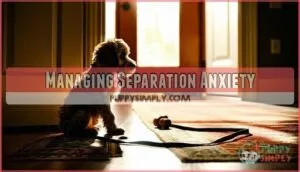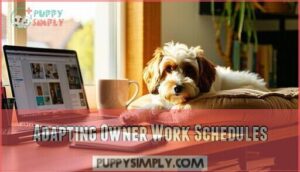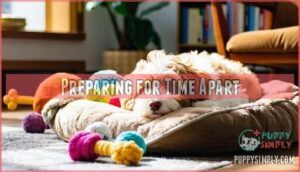This site is supported by our readers. We may earn a commission, at no cost to you, if you purchase through links.

Your cockapoo’s age, training, and temperament all factor into how long can a cockapoo be left alone without turning your home into a chew-toy graveyard.
Set up comfort items like soft music or a piece of your clothing to ease separation anxiety. Gradual training and mental enrichment make all the difference between a peaceful departure and a guilt-inducing goodbye whimper that’ll haunt your workday.
Table Of Contents
Key Takeaways
- Adult cockapoos can handle 4-6 hours alone, while puppies need breaks every 2-3 hours – your dog’s age directly impacts how long they can cope without you around.
- You’ll need to address separation anxiety with gradual training and comfort items – start with short departures and use familiar scents, soft music, or interactive toys to ease their stress.
- Proper toilet training and crate setup prevent accidents during your absence – establish predictable bathroom schedules and create a safe, puppy-proofed space for your cockapoo.
- Mental stimulation and exercise before you leave helps reduce destructive behavior – a tired, mentally engaged cockapoo is much more likely to rest peacefully while you’re gone.
Cockapoo Separation Anxiety
Imagine this: you step out for groceries, and your Cockapoo suddenly acts like you’ve run off to join the circus. Cockapoo separation anxiety is real, with Anxiety Symptoms like nonstop barking, creative chewing, or even those dreaded surprise puddles by the door.
Cockapoos are naturally social creatures who form strong bonds with their families. Your absence triggers their anxiety, but you can ease their stress with simple strategies.
Try leaving soft music playing or placing a piece of your clothing nearby for comfort. These small gestures help your pup feel connected to you even when you’re not home.
Expert guidance can also be a lifesaver if things get out of hand. One size doesn’t fit all, but with patience and the right separation anxiety solutions, you’ll help your Cockapoo feel secure, solo, and ready to greet you with a wag.
Toilet Training Considerations
Toilet training your Cockapoo takes patience and a solid plan. Puppy pads help, but they’re not magic.
Here’s the thing – life throws curveballs, but sticking to a routine saves you from coming home to unpleasant surprises scattered around your house.
Managing Separation Anxiety
Ease Cockapoo separation anxiety by easing into alone time management. Start with gradual separation and make behavioral training part of your daily rhythm.
Create a comforting environment with Calming Products and familiar scents. Try desensitization techniques—leave for short bursts, then build up.
Use video to spot progress and fine-tune your separation anxiety solutions. Trust, patience, and empathy are your best tools.
Preventing Toileting Accidents
Although accidents can happen, a solid potty break schedule is your ace in the hole for a clean home. Focus on three steps:
- Set predictable times for feeding and bathroom breaks.
- Use crate training—it’s not cruel; it’s comforting during alone time.
- Make a puppyproofed indoor potty area for emergency bathroom breaks.
Keep this up—fewer accidents, more peace.
Adapting Owner Work Schedules
With house training a Cockapoo, finding the right mix of Remote Work, Flexible Hours, or even Job Sharing is often the ticket to success. You’re not just avoiding accidents—you’re helping your dog feel safe and loved, too.
Consider using a Dog Walker or looking at Daycare Options to break up the day and ease separation anxiety. The less you leave your Cockapoo alone, the better for your shoes, your sanity, and your pup’s progress on those tough separation anxiety days.
Ideal Alone Time
Once you’ve got toilet training down, here’s the next challenge: figuring out how long your Cockapoo can handle being alone.
These social dogs really need their people around, so short solo time is crucial for happy Cockapoo ownership.
These dogs are a crossbreed of two distinct breeds, so understanding Poodle breed traits is key for their care. Reduce stress and mischief with these go-tos:
- Socialization Outings – Quick dog park runs make a world of difference.
- Interactive Toys – Boredom is the enemy, so battle it with enrichment activities.
- Tasty Food Puzzles – Mind games keep them busy and happy.
- Soothing Background Noises – Calming sounds help your pup relax when you’re out.
Long-Term Solutions
Finding ways to keep your Cockapoo content when you’re not around means thinking long-term. Don’t shy away from consistent training and environmental enrichment—think puzzle toys or hiring a dog walker as lifelines for reducing alone time.
If your dog’s turning into a canine Houdini, consider dog behavior modification, desensitization, or counterconditioning. Sometimes, professional guidance or medication options are worth exploring for separation anxiety management.
You might try:
- Routine adjustments, like enlisting neighbors for quick check-ins
- Adding another pet for company
Preparing for Time Apart
Before heading out, start a pre-departure routine that signals to your Cockapoo everything’s okay—no Oscar-worthy goodbyes! Set up a safe environment by puppyproofing a room and sprinkling in comfort items like a well-loved blanket or toy.
Gradual acclimation, short alone time trials, and plenty of mental enrichment with interactive toys help reduce Cockapoo separation anxiety. Imagine how much smoother your day runs knowing your pup’s not lonely or bored, just waiting for you to stroll back in!
Managing Destructive Behavior
If you’ve ever wondered how to keep your Cockapoo from turning your sofa into modern art, you’re not alone. With proper Chewing Solutions and Scratching Prevention, you can protect your furniture and save your sanity.
Focus on Training Techniques rooted in positive reinforcement—reward calm behavior and provide plenty of exercise. Cockapoo separation anxiety often fuels destructive habits, so leave alone time packed with interactive toys for Anxiety Reduction. Sometimes, a tired Cockapoo is a well-behaved one. Try a quick walk or game of fetch before heading out.
Use the table below for quick ideas:
Adult Dogs Versus Puppies
Ever notice how your puppy follows you everywhere while your neighbor’s grown Cockapoo seems totally fine hanging out solo? It comes down to age differences that really matter. Puppies can only handle 2-3 hours alone, tops. Adult Cockapoos? They’re good for 4-6 hours once they’re properly set up.
Here’s the thing—puppies are still figuring out the world and need constant reassurance during those crucial early months. Cockapoos are naturally prone to separation anxiety because they bond so strongly with their people. Adult dogs have the emotional toolkit and daily routines that help them stay calm when you’re gone. Plus, they’ve learned the most important lesson: you always come back. Puppies haven’t built that trust yet, so every goodbye feels like forever to them.
For puppies, every goodbye feels like forever—they haven’t learned the most important lesson that adult dogs know: you always come back
Puppies develop Cockapoo separation anxiety faster due to their intense socialization needs during those important early months. As a result, Cockapoos are prone to separation anxiety due to their attachment to owners. Adult dogs have established routines and emotional maturity that help them cope better when you leave alone.
Training Impact plays a huge role too—your adult Cockapoo has likely learned that you always come back, while puppies haven’t built that trust yet. These Breed-Specific Needs mean adjusting your schedule based on your dog’s life stage, not just wishful thinking.
Supporting Your Cockapoo’s Needs
Your Cockapoo needs more than just survival basics to truly flourish. These dogs crave structure and meaningful interaction that supports their Mental Wellbeing.
Physical Exercise tailored to your dog’s energy makes all the difference. A well-exercised Cockapoo settles easier when you’re gone. Enrichment Activities – think puzzle feeders and snuffle mats – give their brains something to do during quiet hours.
Socialization Needs shouldn’t be an afterthought. Set up playdates or try doggy daycare. Other dogs can be incredible allies against separation stress. Dietary Requirements play their part too. Regular meal times create that comforting predictability anxious dogs need.
Interactive toys do double duty as entertainment and anxiety relief. A Kong stuffed with goodies can keep your Cockapoo happily occupied for ages. The real goal here is building a world where your dog feels safe, engaged, and cherished – even when you’re not around.
Start with Physical Exercise geared to your Cockapoo’s energy level. A tired dog is often a content dog, making separation anxiety less likely when you leave. Enrichment Activities like puzzle feeders and snuffle mats keep their minds busy during solo hours.
Don’t overlook Socialization Needs – arrange playdates or consider doggy daycare. Canine companionship can work wonders for easing separation distress. Your Cockapoo’s Dietary Requirements matter too. Consistent feeding schedules create predictability, reducing anxiety.
Interactive toys aren’t just entertainment – they’re lifelines during alone time. Kong toys stuffed with treats can occupy your Cockapoo for hours. Remember, addressing Cockapoo separation anxiety means creating an environment where your dog feels secure, stimulated, and loved even when you’re away.
Frequently Asked Questions (FAQs)
Can cockapoos stay overnight without human supervision?
Don’t put all your eggs in one basket—cockapoos shouldn’t stay overnight alone. They’re social dogs prone to anxiety who need human companionship during extended periods, making overnight supervision essential.
What age can cockapoos be left longest?
Adult cockapoos handle alone time best—you can leave them for 4-6 hours comfortably. Puppies need much more attention, with dogs under 6 months requiring breaks every 2 hours maximum.
Do cockapoos need bathroom breaks every hour?
Like tiny clockwork, Cockapoos don’t need hourly pit stops. Adult dogs can generally hold their bladder for 6-8 hours, though older cockapoos may need bathroom breaks every hour during training phases.
Should cockapoos sleep alone at night regularly?
Cockapoos can sleep alone at night, but they’re happiest sharing your bedroom space. Their social nature means complete isolation might trigger anxiety, so consider letting them sleep nearby rather than banishing them completely.
Can weather conditions affect cockapoo alone time?
When push comes to shove, weather absolutely affects your cockapoo’s alone time safety. Extreme temperatures can create dangerous indoor conditions, requiring shorter departures during heat waves or freezing weather to prevent overheating or hypothermia.
Conclusion
Remember, Rome wasn’t built in a day, and neither is your cockapoo’s independence. Understanding how long can a cockapoo be left alone requires patience and realistic expectations.
Start with short departures and gradually build up their tolerance. Every dog’s different, so trust your instincts about what works for your furry companion.
With proper preparation, mental stimulation, and gradual training, you’ll both feel more confident about those necessary separations. Your cockapoo can learn to be content alone while you handle life’s demands.
- https://www.petsradar.com/feature/32-dog-breeds-most-likely-to-have-separation-anxiety
- https://muchadoaboutdoodles.com/cockapoo-separation-anxiety/
- https://www.pets4homes.co.uk/pet-advice/managing-separation-anxiety-in-the-cockapoo.html
- https://www.dogster.com/lifestyle/do-cockapoos-get-separation-anxiety
- https://cockapooownersclubuk.weebly.com/home-alone.html














